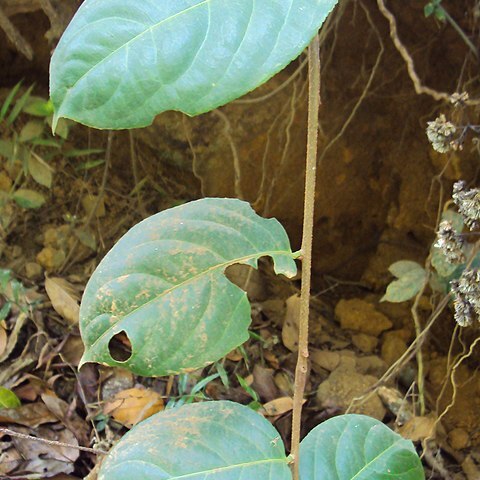Large deciduous twining shrubs, stem up to 23 cm in diam.; bark pale brown, rough and cracked, exfoliating in small scales; branchlets pubescent or glabrous, with prominent elliptic lenticels; axillary buds small, 1-2 mm, triangular. Petiole 6-16 mm; leaf blade elliptic, oblong, rectangular, ovate, or obovate to suborbicular, 5-10 × 2.5-5 cm, glabrous, base cuneate, margin serrate, apex mucronate to acuminate; secondary veins 5-7 pairs, rarely abaxially pubescent at axil of veins. Thyrses terminal, 5-10 cm, 1-or 2-ramous; rachis and pedicels occasionally with short tomentum; pedicels 3-6 mm. Flowers greenish, 5-merous, dioecious, 2-3 × 1.2-1.8 mm; sepals free, imbricate, semiorbicular, ciliate; petals oblong to obovate-rectangular. Disk membranous, cupulate, slightly 5-lobed. Stamens ca. 3 mm, inserted on margin of disk. Ovary globose. Capsule 1-1.3 cm in diam., depressed, globose, 3-valved, bright yellow, 3-6-seeded. Seeds elliptic, 3.5-5.5 × 2-5 mm; aril orange-red. Fl. Apr-Jun, fr. Jun-Sep.
Scandent shrub 2–10 m high; branchlets with conspicuous, pale lenticels. Leaves: lamina elliptic to oblong-elliptic, 5–9 cm long, cuneate to rounded at base, crenate margin, acuminate to obtuse at apex; petiole 0.5–1.5 cm long. Panicles 5–15 cm long, terminal, often on short, lateral shoots, pendulous; pedicels 2 mm long. Calyx lobes c. 1 mm long. Petals oblong, 2.5–3 mm long, obtuse, yellowish green. Disc cupular. Stamens c. 3 mm long in male flowers. Style columnar; stigma 3-or 6-lobed in female flowers. Capsule depressed-globose, 7–8 mm long, 3-angled, with 3 broadly elliptic valves which spread open exposing 3–6 yellowish brown seeds with bright red arils.
A sprawling shrub or large woody climber. The stems can be 23 cm across. The bark is corky. The leaves vary. They can be oval or round. They are 5-11 cm long by 3-7 cm wide. The base is wedge shaped or rounded. The flowers are in large long drooping groups at the ends of branches. Male and female flowers are separate. The fruit is a capsule 9-12 mm across. It has 3 valves with 3-6 seeds. The seeds are yellowish-brown. They have a red fleshy layer around them.

